bird 3
Water and drinking
Water is needed by many birds although their mode of excretion and lack of sweat glands reduces the physiological demands.[160] Some desert birds can obtain their water needs entirely from moisture in their food. Some have other adaptations such as allowing their body temperature to rise, saving on moisture loss from evaporative cooling or panting.[161] Seabirds can drink seawater and have salt glands inside the head that eliminate excess salt out of the nostrils.[162]
Most birds scoop water in their beaks and raise their head to let water run down the throat. Some species, especially of arid zones, belonging to the pigeon, finch, mousebird, button-quail and bustard families are capable of sucking up water without the need to tilt back their heads.[163] Some desert birds depend on water sources and sandgrouse are particularly well known for congregating daily at waterholes. Nesting sandgrouse and many plovers carry water to their young by wetting their belly feathers.[164] Some birds carry water for chicks at the nest in their crop or regurgitate it along with food. The pigeon family, flamingos and penguins have adaptations to produce a nutritive fluid called crop milk that they provide to their chicks.[165]
Feather care
Main article: Preening
Feathers, being critical to the survival of a bird, require maintenance. Apart from physical wear and tear, feathers face the onslaught of fungi, ectoparasitic feather mites and bird lice.[166] The physical condition of feathers are maintained by preening often with the application of secretions from the preen gland. Birds also bathe in water or dust themselves. While some birds dip into shallow water, more aerial species may make aerial dips into water and arboreal species often make use of dew or rain that collect on leaves. Birds of arid regions make use of loose soil to dust-bathe. A behaviour termed as anting in which the bird encourages ants to run through their plumage is also thought to help them reduce the ectoparasite load in feathers. Many species will spread out their wings and expose them to direct sunlight and this too is thought to help in reducing fungal and ectoparasitic activity that may lead to feather damage.[167][168]
Migration
Main article: Bird migration A flock of Canada geese in V formation
A flock of Canada geese in V formation
Many bird species migrate to take advantage of global differences of seasonal temperatures, therefore optimising availability of food sources and breeding habitat. These migrations vary among the different groups. Many landbirds, shorebirds, and waterbirds undertake annual long-distance migrations, usually triggered by the length of daylight as well as weather conditions. These birds are characterised by a breeding season spent in the temperate or polar regions and a non-breeding season in the tropical regions or opposite hemisphere. Before migration, birds substantially increase body fats and reserves and reduce the size of some of their organs.[169][170]
Migration is highly demanding energetically, particularly as birds need to cross deserts and oceans without refuelling. Landbirds have a flight range of around 2,500 km (1,600 mi) and shorebirds can fly up to 4,000 km (2,500 mi),[76] although the bar-tailed godwit is capable of non-stop flights of up to 10,200 km (6,300 mi).[171] Seabirds also undertake long migrations, the longest annual migration being those of sooty shearwaters, which nest in New Zealand and Chile and spend the northern summer feeding in the North Pacific off Japan, Alaska and California, an annual round trip of 64,000 km (39,800 mi).[172] Other seabirds disperse after breeding, travelling widely but having no set migration route. Albatrosses nesting in the Southern Ocean often undertake circumpolar trips between breeding seasons.[173] The routes of satellite-tagged bar-tailed godwits migrating north from New Zealand. This species has the longest known non-stop migration of any species, up to 10,200 km (6,300 mi).
The routes of satellite-tagged bar-tailed godwits migrating north from New Zealand. This species has the longest known non-stop migration of any species, up to 10,200 km (6,300 mi).
Some bird species undertake shorter migrations, travelling only as far as is required to avoid bad weather or obtain food. Irruptive species such as the boreal finches are one such group and can commonly be found at a location in one year and absent the next. This type of migration is normally associated with food availability.[174] Species may also travel shorter distances over part of their range, with individuals from higher latitudes travelling into the existing range of conspecifics; others undertake partial migrations, where only a fraction of the population, usually females and subdominant males, migrates.[175] Partial migration can form a large percentage of the migration behaviour of birds in some regions; in Australia, surveys found that 44% of non-passerine birds and 32% of passerines were partially migratory.[176]
Altitudinal migration is a form of short-distance migration in which birds spend the breeding season at higher altitudes and move to lower ones during suboptimal conditions. It is most often triggered by temperature changes and usually occurs when the normal territories also become inhospitable due to lack of food.[177] Some species may also be nomadic, holding no fixed territory and moving according to weather and food availability. Parrots as a family are overwhelmingly neither migratory nor sedentary but considered to either be dispersive, irruptive, nomadic or undertake small and irregular migrations.[178]
The ability of birds to return to precise locations across vast distances has been known for some time; in an experiment conducted in the 1950s, a Manx shearwater released in Boston in the United States returned to its colony in Skomer, in Wales within 13 days, a distance of 5,150 km (3,200 mi).[179] Birds navigate during migration using a variety of methods. For diurnal migrants, the sun is used to navigate by day, and a stellar compass is used at night. Birds that use the sun compensate for the changing position of the sun during the day by the use of an internal clock.[76] Orientation with the stellar compass depends on the position of the constellations surrounding Polaris.[180] These are backed up in some species by their ability to sense the Earth's geomagnetism through specialised photoreceptors.[181]
Communication
See also: Bird vocalisation

Bird song
Duration: 39 seconds.
0:39
Song of the house wren, a common North American songbird
Mimicry
Duration: 23 seconds.
0:23
A tooth-billed bowerbird mimicking a spangled drongo
Drumming
Duration: 3 seconds.
0:03
A woodpecker drumming on wood
Problems playing these files? See media help.
Birds communicate primarily using visual and auditory signals. Signals can be interspecific (between species) and intraspecific (within species).
Birds sometimes use plumage to assess and assert social dominance,[182] to display breeding condition in sexually selected species, or to make threatening displays, as in the sunbittern's mimicry of a large predator to ward off hawks and protect young chicks.[183] The startling display of the sunbittern mimics a large predator.
The startling display of the sunbittern mimics a large predator.
Visual communication among birds may also involve ritualised displays, which have developed from non-signalling actions such as preening, the adjustments of feather position, pecking, or other behaviour. These displays may signal aggression or submission or may contribute to the formation of pair-bonds.[76] The most elaborate displays occur during courtship, where "dances" are often formed from complex combinations of many possible component movements;[184] males' breeding success may depend on the quality of such displays.[185]
Bird calls and songs, which are produced in the syrinx, are the major means by which birds communicate with sound. This communication can be very complex; some species can operate the two sides of the syrinx independently, allowing the simultaneous production of two different songs.[103] Calls are used for a variety of purposes, including mate attraction,[76] evaluation of potential mates,[186] bond formation, the claiming and maintenance of territories,[76] the identification of other individuals (such as when parents look for chicks in colonies or when mates reunite at the start of breeding season),[187] and the warning of other birds of potential predators, sometimes with specific information about the nature of the threat.[188] Some birds also use mechanical sounds for auditory communication. The Coenocorypha snipes of New Zealand drive air through their feathers,[189] woodpeckers drum for long-distance communication,[190] and palm cockatoos use tools to drum.[191]
Flocking and other associations
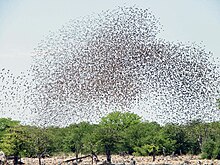 Red-billed queleas, the most numerous species of wild bird,[192] form enormous flocks – sometimes tens of thousands strong.
Red-billed queleas, the most numerous species of wild bird,[192] form enormous flocks – sometimes tens of thousands strong.
While some birds are essentially territorial or live in small family groups, other birds may form large flocks. The principal benefits of flocking are safety in numbers and increased foraging efficiency.[76] Defence against predators is particularly important in closed habitats like forests, where ambush predation is common and multiple eyes can provide a valuable early warning system. This has led to the development of many mixed-species feeding flocks, which are usually composed of small numbers of many species; these flocks provide safety in numbers but increase potential competition for resources.[193] Costs of flocking include bullying of socially subordinate birds by more dominant birds and the reduction of feeding efficiency in certain cases.[194]
Birds sometimes also form associations with non-avian species. Plunge-diving seabirds associate with dolphins and tuna, which push shoaling fish towards the surface.[195] Some species of hornbills have a mutualistic relationship with dwarf mongooses, in which they forage together and warn each other of nearby birds of prey and other predators.[196]
Resting and roosting
"Roosting" redirects here. For other uses, see Roost.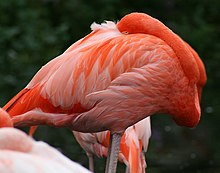 Many birds, like this American flamingo, tuck their head into their back when sleeping.
Many birds, like this American flamingo, tuck their head into their back when sleeping.
The high metabolic rates of birds during the active part of the day is supplemented by rest at other times. Sleeping birds often use a type of sleep known as vigilant sleep, where periods of rest are interspersed with quick eye-opening "peeks", allowing them to be sensitive to disturbances and enable rapid escape from threats.[197] Swifts are believed to be able to sleep in flight and radar observations suggest that they orient themselves to face the wind in their roosting flight.[198] It has been suggested that there may be certain kinds of sleep which are possible even when in flight.[199]
Some birds have also demonstrated the capacity to fall into slow-wave sleep one hemisphere of the brain at a time. The birds tend to exercise this ability depending upon its position relative to the outside of the flock. This may allow the eye opposite the sleeping hemisphere to remain vigilant for predators by viewing the outer margins of the flock. This adaptation is also known from marine mammals.[200] Communal roosting is common because it lowers the loss of body heat and decreases the risks associated with predators.[201] Roosting sites are often chosen with regard to thermoregulation and safety.[202] Unusual mobile roost sites include large herbivores on the African savanna that are used by oxpeckers.[203]
Many sleeping birds bend their heads over their backs and tuck their bills in their back feathers, although others place their beaks among their breast feathers. Many birds rest on one leg, while some may pull up their legs into their feathers, especially in cold weather. Perching birds have a tendon-locking mechanism that helps them hold on to the perch when they are asleep. Many ground birds, such as quails and pheasants, roost in trees. A few parrots of the genus Loriculus roost hanging upside down.[204] Some hummingbirds go into a nightly state of torpor accompanied with a reduction of their metabolic rates.[205] This physiological adaptation shows in nearly a hundred other species, including owlet-nightjars, nightjars, and woodswallows. One species, the common poorwill, even enters a state of hibernation.[206] Birds do not have sweat glands, but can lose water directly through the skin, and they may cool themselves by moving to shade, standing in water, panting, increasing their surface area, fluttering their throat or using special behaviours like urohidrosis to cool themselves.[207][208]
Breeding
See also: Category:Avian sexuality, Animal sexual behaviour § Birds, Seabird breeding behaviour, and Sexual selection in birds
Social systems
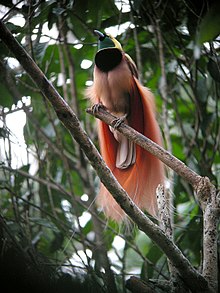 Like others of its family, the male Raggiana bird-of-paradise has elaborate breeding plumage used to impress females.[209]
Like others of its family, the male Raggiana bird-of-paradise has elaborate breeding plumage used to impress females.[209]
Ninety-five per cent of bird species are socially monogamous. These species pair for at least the length of the breeding season or—in some cases—for several years or until the death of one mate.[210] Monogamy allows for both paternal care and biparental care, which is especially important for species in which care from both the female and the male parent is required in order to successfully rear a brood.[211] Among many socially monogamous species, extra-pair copulation (infidelity) is common.[212] Such behaviour typically occurs between dominant males and females paired with subordinate males, but may also be the result of forced copulation in ducks and other anatids.[213]
For females, possible benefits of extra-pair copulation include getting better genes for her offspring and insuring against the possibility of infertility in her mate.[214] Males of species that engage in extra-pair copulations will closely guard their mates to ensure the parentage of the offspring that they raise.[215]
Other mating systems, including polygyny, polyandry, polygamy, polygynandry, and promiscuity, also occur.[76] Polygamous breeding systems arise when females are able to raise broods without the help of males.[76] Mating systems vary across bird families[216] but variations within species are thought to be driven by environmental conditions.[217]
Breeding usually involves some form of courtship display, typically performed by the male.[218] Most displays are rather simple and involve some type of song. Some displays, however, are quite elaborate. Depending on the species, these may include wing or tail drumming, dancing, aerial flights, or communal lekking. Females are generally the ones that drive partner selection,[219] although in the polyandrous phalaropes, this is reversed: plainer males choose brightly coloured females.[220] Courtship feeding, billing and allopreening are commonly performed between partners, generally after the birds have paired and mated.[221]
Homosexual behaviour has been observed in males or females in numerous species of birds, including copulation, pair-bonding, and joint parenting of chicks.[222] Over 130 avian species around the world engage in sexual interactions between the same sex or homosexual behaviours. "Same-sex courtship activities may involve elaborate displays, synchronized dances, gift-giving ceremonies, or behaviors at specific display areas including bowers, arenas, or leks."[223]
Territories, nesting and incubation
See also: Bird nest
Many birds actively defend a territory from others of the same species during the breeding season; maintenance of territories protects the food source for their chicks. Species that are unable to defend feeding territories, such as seabirds and swifts, often breed in colonies instead; this is thought to offer protection from predators. Colonial breeders defend small nesting sites, and competition between and within species for nesting sites can be intense.[224]
All birds lay amniotic eggs with hard shells made mostly of calcium carbonate.[76] Hole and burrow nesting species tend to lay white or pale eggs, while open nesters lay camouflaged eggs. There are many exceptions to this pattern, however; the ground-nesting nightjars have pale eggs, and camouflage is instead provided by their plumage. Species that are victims of brood parasites have varying egg colours to improve the chances of spotting a parasite's egg, which forces female parasites to match their eggs to those of their hosts.[225]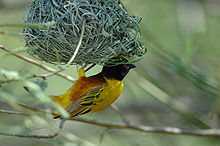 Male golden-backed weavers construct elaborate suspended nests out of grass.
Male golden-backed weavers construct elaborate suspended nests out of grass.
Bird eggs are usually laid in a nest. Most species create somewhat elaborate nests, which can be cups, domes, plates, mounds, or burrows.[226] Some bird nests can be a simple scrape, with minimal or no lining; most seabird and wader nests are no more than a scrape on the ground. Most birds build nests in sheltered, hidden areas to avoid predation, but large or colonial birds—which are more capable of defence—may build more open nests. During nest construction, some species seek out plant matter from plants with parasite-reducing toxins to improve chick survival,[227] and feathers are often used for nest insulation.[226] Some bird species have no nests; the cliff-nesting common guillemot lays its eggs on bare rock, and male emperor penguins keep eggs between their body and feet. The absence of nests is especially prevalent in open habitat ground-nesting species where any addition of nest material would make the nest more conspicuous. Many ground nesting birds lay a clutch of eggs that hatch synchronously, with precocial chicks led away from the nests (nidifugous) by their parents soon after hatching.[228]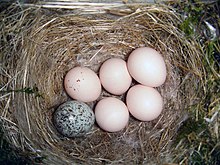 Nest of an eastern phoebe that has been parasitised by a brown-headed cowbird
Nest of an eastern phoebe that has been parasitised by a brown-headed cowbird
Incubation, which regulates temperature for chick development, usually begins after the last egg has been laid.[76] In monogamous species incubation duties are often shared, whereas in polygamous species one parent is wholly responsible for incubation. Warmth from parents passes to the eggs through brood patches, areas of bare skin on the abdomen or breast of the incubating birds. Incubation can be an energetically demanding process; adult albatrosses, for instance, lose as much as 83 grams (2.9 oz) of body weight per day of incubation.[229] The warmth for the incubation of the eggs of megapodes comes from the sun, decaying vegetation or volcanic sources.[230] Incubation periods range from 10 days (in woodpeckers, cuckoos and passerine birds) to over 80 days (in albatrosses and kiwis).[76]
The diversity of characteristics of birds is great, sometimes even in closely related species. Several avian characteristics are compared in the table below.[231][232]
SpeciesAdult weight
(grams)Incubation
(days)Clutches
(per year)Clutch sizeRuby-throated hummingbird (Archilochus colubris)3132.02House sparrow (Passer domesticus)25114.55Greater roadrunner (Geococcyx californianus)376201.54Turkey vulture (Cathartes aura)2,200391.02Laysan albatross (Phoebastria immutabilis)3,150641.01Magellanic penguin (Spheniscus magellanicus)4,000401.01Golden eagle (Aquila chrysaetos)4,800401.02Wild turkey (Meleagris gallopavo)6,050281.011
Parental care and fledging
Main article: Parental care in birds
At the time of their hatching, chicks range in development from helpless to independent, depending on their species. Helpless chicks are termed altricial, and tend to be born small, blind, immobile and naked; chicks that are mobile and feathered upon hatching are termed precocial. Altricial chicks need help thermoregulating and must be brooded for longer than precocial chicks. The young of many bird species do not precisely fit into either the precocial or altricial category, having some aspects of each and thus fall somewhere on an "altricial-precocial spectrum".[233] Chicks at neither extreme but favouring one or the other may be termed semi-precocial[234] or semi-altricial.[235] Altricial chicks of a white-breasted woodswallow
Altricial chicks of a white-breasted woodswallow
The length and nature of parental care varies widely amongst different orders and species. At one extreme, parental care in megapodes ends at hatching; the newly hatched chick digs itself out of the nest mound without parental assistance and can fend for itself immediately.[236] At the other extreme, many seabirds have extended periods of parental care, the longest being that of the great frigatebird, whose chicks take up to six months to fledge and are fed by the parents for up to an additional 14 months.[237] The chick guard stage describes the period of breeding during which one of the adult birds is permanently present at the nest after chicks have hatched. The main purpose of the guard stage is to aid offspring to thermoregulate and protect them from predation.[238]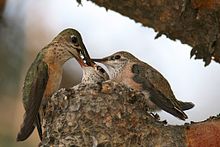 A female calliope hummingbird feeding fully grown chicks
A female calliope hummingbird feeding fully grown chicks
In some species, both parents care for nestlings and fledglings; in others, such care is the responsibility of only one sex. In some species, other members of the same species—usually close relatives of the breeding pair, such as offspring from previous broods—will help with the raising of the young.[239] Such alloparenting is particularly common among the Corvida, which includes such birds as the true crows, Australian magpie and fairy-wrens,[240] but has been observed in species as different as the rifleman and red kite. Among most groups of animals, male parental care is rare. In birds, however, it is quite common—more so than in any other vertebrate class.[76] Although territory and nest site defence, incubation, and chick feeding are often shared tasks, there is sometimes a division of labour in which one mate undertakes all or most of a particular duty.[241]
The point at which chicks fledge varies dramatically. The chicks of the Synthliboramphus murrelets, like the ancient murrelet, leave the nest the night after they hatch, following their parents out to sea, where they are raised away from terrestrial predators.[242] Some other species, such as ducks, move their chicks away from the nest at an early age. In most species, chicks leave the nest just before, or soon after, they are able to fly. The amount of parental care after fledging varies; albatross chicks leave the nest on their own and receive no further help, while other species continue some supplementary feeding after fledging.[243] Chicks may also follow their parents during their first migration.[244]






























